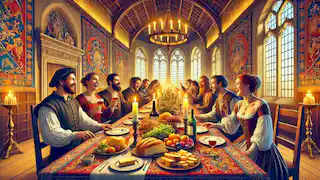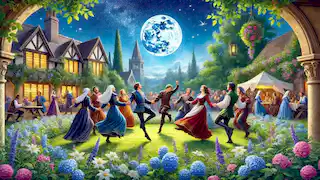The Outbreak
In the year 1348, Florence was a city gripped by the terror of the Black Death. The streets were eerily quiet, punctuated only by the occasional wail of a mourning family. Buildings stood like silent sentinels over the chaos, their windows dark and foreboding. Amid this turmoil, a group of ten friends—seven women and three men—decided to flee the city and find refuge in the countryside, seeking solace and safety from the plague's relentless march.
Pampinea, the eldest and wisest among them, proposed the plan. “We shall retire to my family's villa in the hills. There, we can wait out this plague in relative peace, away from the city's horrors.”
Her suggestion was met with unanimous agreement. Thus, on a crisp morning, they set out, each carrying what little they could from their former lives. As they walked through the city gates, they left behind the stench of death, the somber tolling of church bells, and the despair that hung thick in the air.

The Sanctuary
The villa stood atop a gentle hill, surrounded by lush vineyards and olive groves. It was a grand estate, its white stone walls gleaming in the sunlight, offering a stark contrast to the dark mood that lingered from their journey. The friends settled into their new home, grateful for the sanctuary it provided.
Each day, they would gather in the great hall, its high ceilings and elaborate tapestries a reminder of the wealth that had once flowed freely in Florence. To pass the time and keep their spirits high, Pampinea suggested they tell stories. Each day, one person would narrate a tale, providing entertainment and a sense of normalcy amid the chaos.
The First Story
On the first day, it was Filomena’s turn to tell a story. She spoke of a merchant named Federigo, who had fallen in love with Monna Giovanna, a woman of great beauty and virtue. Despite his attempts to win her heart, Federigo’s love remained unrequited. He spent his fortune trying to impress her, and soon, he was left with nothing but a small farm and a beloved falcon.
One day, Monna Giovanna's son fell gravely ill and longed for Federigo’s falcon. Desperate to save her son, Monna Giovanna visited Federigo and asked for the bird. Unaware of her true intent, Federigo, in an act of pure love, cooked the falcon and served it to her. When Monna Giovanna discovered this, she was moved by his sacrifice and, after her son’s death, married him. Thus, Federigo’s unwavering love and generosity were finally rewarded.
The Second Story
The following day, it was Dioneo’s turn. Known for his wit and charm, he chose a humorous tale to lighten the mood. He told the story of a young woman named Alibech, who, in her naïveté, sought to serve God by going into the desert. There, she met a hermit named Rustico, who convinced her that the best way to serve God was to help him "put the Devil back into Hell." Through a series of comedic encounters, Alibech eventually returned home, wiser and more aware of the ways of the world.
The Festivities
To celebrate the end of each day, the group held feasts in the villa’s grand dining room. The table was laden with bread, cheese, fruits, and wine from the local vineyards. The laughter and conversation that filled the room were a stark contrast to the sorrow that lay beyond their sanctuary.
One evening, as they dined under the soft glow of candlelight, Pampinea noticed a change in the atmosphere. The stories, the companionship, and the relative safety of their surroundings had begun to lift the veil of despair that had shrouded their hearts. They were not merely surviving; they were living.

The Third Story
On the third day, it was Elissa’s turn. She narrated the tale of Tancredi, the Prince of Salerno, and his daughter Ghismonda. Tancredi had kept his daughter sheltered, but she fell in love with Guiscardo, a man of lower rank. When Tancredi discovered their affair, he had Guiscardo killed and sent his heart to Ghismonda in a golden cup. Stricken with grief, Ghismonda drank poison and died, clutching the cup to her chest.
This tragic story moved everyone to tears, a poignant reminder of the fragility of life and love.
The Garden
After days of storytelling and feasting, the group decided to explore the villa’s gardens. The gardens were a paradise, filled with vibrant flowers, trickling fountains, and shaded groves. It was a place of peace, where they could escape the world and find solace in nature’s embrace.
One afternoon, as they strolled through the gardens, they came upon a secluded pond. The water was crystal clear, reflecting the azure sky above. It was here that they often gathered to share their thoughts, their hopes, and their dreams.
The Fourth Story
Lauretta, the quietest of the group, chose to tell the fourth story. She spoke of a noble knight named Messer Torello, who was separated from his wife during the Crusades. Captured and sold into slavery, he rose to a position of respect in the Sultan's court. Years later, he was finally able to return home, just in time to prevent his wife’s remarriage. Their reunion was a testament to the enduring power of love and faith.
The Celebration
As the days turned into weeks, the group found new ways to celebrate life. They held music and dance nights in the grand hall, their laughter echoing through the villa. The women adorned themselves with flowers from the garden, while the men played instruments and sang songs of joy and hope.
One evening, as they danced under the stars, Filostrato, the most melancholic of the group, finally smiled. The plague might have taken much from them, but it had not taken their spirit. Together, they had found a way to reclaim their humanity.

The Fifth Story
On the fifth day, it was Neifile’s turn to tell a story. She spoke of Lisabetta, a young woman who fell in love with a poor youth named Lorenzo. Her brothers, discovering the affair, murdered Lorenzo and buried his body. Lisabetta, guided by a dream, found his grave and unearthed his head, which she placed in a pot of basil. Watered by her tears, the basil grew lush and green, a symbol of her undying love and grief.
The Return
The day finally came when the group had to return to Florence. The news had reached them that the plague had subsided, and life was slowly returning to the city. With heavy hearts, they packed their belongings and bid farewell to the villa that had been their refuge.
As they walked back to the city, they carried with them the stories they had shared, the memories they had made, and the bonds that had strengthened among them. The journey back was bittersweet, a reminder of the resilience of the human spirit in the face of adversity.
The New Beginning
Returning to Florence, the friends found a city forever changed by the plague. Many of their loved ones were gone, and the streets were still haunted by the memories of loss. Yet, amid the ruins, there was a sense of rebirth. People were rebuilding their lives, their homes, and their city.
Pampinea and her friends vowed to keep their tradition of storytelling alive. They would meet regularly, not just to remember the past, but to celebrate the future. The stories they told would serve as a beacon of hope, a testament to their survival, and a tribute to those they had lost.
The Legacy
Years passed, and the friends grew older. They married, had children, and watched as their city flourished once more. But the bond they had forged during those dark days in the villa remained unbroken. They continued to gather, to tell stories, and to celebrate life.
The Decameron, as their collection of tales came to be known, became a cherished legacy, passed down through generations. It was a reminder of a time when ten friends had faced the worst the world had to offer and had emerged stronger, united by their love for each other and their unyielding spirit.
The Final Tale
In their final years, the friends decided to write down their stories. They gathered in the villa once more, now a place of fond memories rather than refuge. Each of them contributed their favorite tales, creating a rich tapestry of human experience—love, loss, joy, sorrow, humor, and wisdom.
As they finished their work, they looked at each other with tears in their eyes. They had lived through a time of great trial and had come out the other side with stories that would outlast them. Their legacy was secure, their stories a gift to the future.

The Eternal Bond
On a bright spring morning, Pampinea, now an old woman, sat in the garden of the villa. The air was filled with the scent of blooming flowers, and the sun shone warmly on her face. She closed her eyes and listened to the distant laughter of children playing, a sound that filled her heart with peace.
She thought of her friends, now scattered by the winds of time, and smiled. They had shared something extraordinary, something that would never be forgotten. The Dec
ameron was more than just a collection of stories; it was a testament to their courage, their friendship, and their enduring love.
And so, the stories lived on, a beacon of hope for future generations, a reminder that even in the darkest of times, the human spirit could shine bright and beautiful.




















